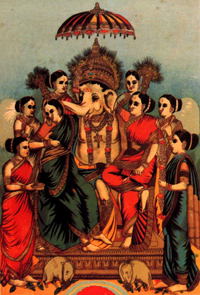Siddhi
Siddhi (Devanagari सिद्धि; IAST: siddhi; Tibetan: དངོས་གྲུབ, Wylie: dngos grub) is a Sanskrit noun that can be translated as "perfection", "accomplishment", "attainment", or "success". The term is first attested in the Mahabharata. In the Pancatantra, a siddhi may be any unusual skill or faculty or capability. As a term in the Manusmriti, it refers to the settlement of a debt.
In the Samkhya Karika and Tattva Samasa, it refers to the attainment of eight siddhis that make one become rid of pain-causing ignorance, to gain knowledge, and experience bliss. In Tantric Buddhism, it specifically refers to the acquisition of supernatural powers by psychic or magical means or the supposed faculty so acquired. These powers include items such as clairvoyance, levitation, bilocation, becoming as small as an atom, materialization, having access to memories from past lives, etc. The term is also used in this sense in the Sarva-darśana-saṃgraha of Madhvacharya (1238–1317).
In Patanjali's Yoga Sutras IV.1 it is stated (rendered in IAST):
- janma auṣadhi mantra tapaḥ samādhijāḥ siddhayaḥ
where janma ("birth"), auṣadhi ("medicinal plant, herb, drug, incense, elixir"), mantra ("incantation, charm, spell"), tapaḥ ("heat, burning, shining, as ascetic devotional practice, burning desire to reach perfection, that which burns all impurities"), samādhi ("profound meditation, total absorption"), jāḥ ("born") and siddhayaḥ ("perfections, accomplishments, fulfillments, attainments") are rendered in English by Iyengar (1966, 2002: p. 246) thus:
- Accomplishments may be attained through birth, the use of herbs, incantations, self-discipline or samadhi.
Five siddhis of Yoga and meditation
In the Bhagavata Purana, the five siddhis of Yoga and meditation are described as below:
- tri-kāla-jñatvam: knowing the past, present and future
- advandvam: tolerance of heat, cold and other dualities
- para citta ādi abhijñatā: knowing the minds of others and so on
- agni arka ambu viṣa ādīnām pratiṣṭambhaḥ: checking the influence of fire, sun, water, poison, and so on
- aparājayah: remaining unconquered by others
Eight primary siddhis

There is the concept of the Ashta Siddhi (eight siddhis) in Hinduism. These are:
- Aṇimā: reducing one's body even to the size of an atom
- Mahima: expanding one's body to an infinitely large size
- Garima: becoming infinitely heavy
- Laghima: becoming almost weightless
- Prāpti: having unrestricted access to all places
- Prākāmya: realizing whatever one desires
- Iṣṭva: possessing absolute lordship
- Vaśtva: the power to subjugate all
The eight siddhis hinted at by Kapila in his Sutra - अष्टधा सिद्धिः ||१५|| - are as explained in Verse 51 of Samkhyakarika :-
- Uuha: based on the samskaras of previous births the attainment of knowledge about the twenty-four Tatwas gained by examining the determinable and the indeterminable conscious and the non-conscious constituents of creation,
- Shabad: knowledge gained by associating with an enlightened person (Guru – upadesh),
- Addhyyan: knowledge gained through study of the Vedas and other standard ancillary texts,
- Suhritprapti: knowledge gained from a kind-hearted person, while engaged in the spread of knowledge
- Daan: knowledge gained regardless of one’s own needs while attending to the requirements of those engaged in the search of the highest truth,
- Aadhyaatmik dukkh-haan: freedom from pain, disappointment, etc; arising due to lack of spiritual, metaphysical, mystic knowledge and experience,
- Aadhibhautik dukkh-haan: freedom from pain etc; arising by possessing and being attached to various materialistic gains,
- Aadhidaivik dukkh-haan: freedom from pain etc; caused by fate or due to reliance on fate,
the attainment of which eight siddhis makes one become rid of pain-causing ignorance through gain of knowledge, and experience bliss. The aim of Samkhya is to eliminate all kinds of physical and mental pains and to receive liberation.
Ten secondary siddhis
In the Bhagavata Purana, Lord Krishna describes the ten secondary siddhis as:
- anūrmi-mattvam: Being undisturbed by hunger, thirst, and other bodily disturbances
- dūra-śravaṇa: Hearing things far away
- dūra-darśanam: Seeing things far away
- manaḥ-javah: Moving the body wherever thought goes (teleportation/astral projection)
- kāma-rūpam: Assuming any form desired
- para-kāya praveśanam: Entering the bodies of others
- sva-chanda mṛtyuh: Dying when one desires
- devānām saha krīḍā anudarśanam: Witnessing and participating in the pastimes of the gods
- yathā sańkalpa saḿsiddhiḥ: Perfect accomplishment of one's determination
- ājñā apratihatā gatiḥ: Orders or commands being unimpeded
Hindu gods associated with gaining siddhi
In Hinduism, both Ganesha and Hanuman possess the eight supernatural powers (ashtamahasiddhis) and can give one access to Ashta Siddhis.
